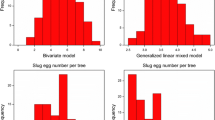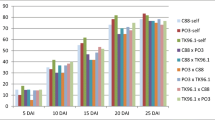Abstract
HA89, a sunflower line susceptible to Phomopsis, was crossed with a resistant line, LR4-17. Two hundred and forty-one F2/F3 progenies and 232 recombinant inbred (RI) lines were derived from this cross. F2/F3 progenies were tested in semi-natural infections in 1994. F7, F8 and F9 were tested with semi-natural infections in 1997, 1998 and 1999, respectively. F7 RI lines were artificially infected with Phomopsis mycelium on leaves in 1997. Family effects were significant in F2/F3 progenies for attack rates on stems and encircling spots rates on stems after semi-natural infections. Line effects were significant for attack rates on stems and encircling spot rates in F7 and F8. F7 RI lines showed a high heritability for speed of necrosis on leaf blades after artificial infection. Continuous and unimodal distributions were observed for attack rates on stems in all experiments done in semi-natural conditions. In contrast, speed of necrosis on leaf blades showed a bimodal distribution. Significant rank correlations were observed between the speed of necrosis on leaf blades and the attack rates on stems. It is suggested that resistance to Phomopsis is the consequence of several mechanisms, independently inherited. It was concluded that speed of necrosis on leaf blades in artificial infections and attack rates on stems in natural infections should be retained as parameters for quantitative trait locus mapping of Phomopsis resistance.
Similar content being viewed by others
References
Bertrand F and Tourvieille D (1987) Phomopsis tournesol: Tests de sélection. Informations Techniques CETIOM 98: 12–18
Besnard G, Griveau Y, Quillet MC, Serieys H, Lambert P, Varès D and Bervillè A (1997) Specifying of introgressed regions from H. argophyllus in cultivated sunflower (Helianthus annuus) to mark Phomopsis resistance genes. Theoretical and Applied Genetics 94: 131–138
Burr B and Burr FA (1991) Recombinant inbreds for molecular mapping in maize: theoretical and practical considerations. Trends in Genetics 7: 55–60
Degener J, Melchinger EA and Hahn V (1999) Inheritance of resistance to Phomopsis in sunflower: Study of leaf and stem resistance after artificial and natural infection, Helia 22: 105–115
Deglène L, Alibert G, Lesigne P, Tourvieille de Labrouhe D and Sarrafi A (1999) Inheritance of resistance to stem canker (Phomopsis helianthi) in sunflower. Plant Pathology 48: 559–563
Gallais A (1990) Théorie de la sélection et amélioration des plantes, Masson, Paris, 588 p
Griveau Y, Serieys H and Belhassen E (1992). Resistance evaluation of interspecific and cultivated progenies of sunflower infected by Diaporthe helianthi. In: Proceedings of the 13th International Sunflower Conference, Vol II, Pisa, Italy, 7–11 September, (pp 1054–1058)
Langar K, Griveau Y, Vares D and Bervillé A (1997) Evaluation of resistance to Phomopsis on wild species, cultivars and inbreds of sunflower with artificial and seminatural infections. 10th Congress of the Mediterranean Phytopathological Union, Montpellier, France, 1–5 June (pp 831–837)
Langar K, Griveau Y, Ziercher L, Serieys H and Bervillé A (2000) Comportement de génotypes de tournesol (Helianthus annuus L.) vis-í-vis de cinq isolats de Phomopsis (Diaporthe helianthi Munt-Cvet. et al.) observé í partir d'infections artificielles sur feuilles, In: Proceedings of the 15th International Sunflower Conference, Vol II, Toulouse, France, (pp K96–101)
Pinochet X and Estragnat A (1996) Field evaluation of hybrid sensitivity to Diaporthe helianthi: relation between symptoms and yield losses. In: Proceedings of the 14th International Sunflower Conference, Beijing, China, Symposium I: Disease tolerance in sunflower, (pp 102–105)
Piquemal G (1970) How to produce hybrid sunflower seeds by inducing male sterility with gibberellic acid. In: Proceedings of the 4th International Sunflower Conference, 23–25 June Memphis, USA, (pp 127–135)
SAS Institute (1996) SAS/STAT language guide for personal computers. Release 6.12.SAS Institute, Cary, NC, USA
Schneiter AA and Miller JF (1981) Description of sunflower growth stages. Crop Science 21: 901–903
Shapiro SS and Wilk MB (1965) An Analysis of Variance Test for Normality (Complete Samples). Biometrika 52: 591–611
Skoric D (1985) Sunflower breeding for resistance to Diaporthe/Phomopsis helianthi Munt-Cvet et al. Helia 8: 21–24
Tourvieille D and Vear F (1986) Culture du tournesol sous tunnel en filet avec humectation contrôlée pour l'étude du Sclerotinia sclerotiorum. Informations Techniques CETIOM 96: 20–28
Vear F, Garreyn M and Tourvieille D (1997) Inheritance of resistance to Phomopsis (Diaporthe helianthi) in sunflower. Plant Breeding, Berlin 116: 277–281
Viguié A, Vear F and Tourvieille de Labrouhe D (1999). Interaction between French isolates of Phomopsis/Diaporthe helianthi Munt-Cvet et al. and sunflower (Helianthus annuus L.) genotypes. European Journal of Plant Pathology 105: 693–702
Viguié A, Tourvieille de Labrouhe D and Vear F (2000) Inheritance of several sources of resistance to Phomopsis stem canker (Diaporthe helianthi Munt-Cvet.) in sunflower (Helianthus annuus L.). Euphytica 116: 167–179
Vranceanu AV, Craiciu DS, Soare G, Pacureanu AV, Voinescu G and Sandu I (1993) Sunflower genetic resistance to Phomopsis helianthi attack. In: Proceedings of the 13th International Sunflower Conference, Vol II, Pisa, Italy, (pp 1301–1306)
Author information
Authors and Affiliations
Corresponding author
Rights and permissions
About this article
Cite this article
Langar, K., Griveau, Y., Kaan, F. et al. Evaluation of Parameters Accounting for Phomopsis Resistance Using Natural Infection and Artificial Inoculation on Recombinant Inbred Lines From a Cross Between Susceptible and Resistant Sunflower. European Journal of Plant Pathology 108, 307–315 (2002). https://doi.org/10.1023/A:1015697802637
Issue Date:
DOI: https://doi.org/10.1023/A:1015697802637




